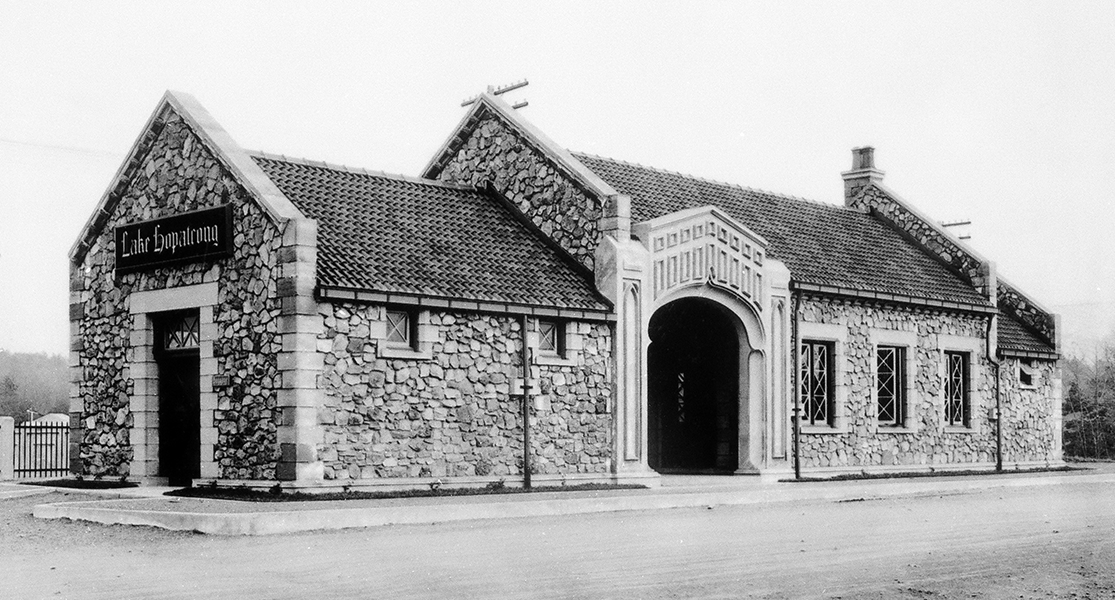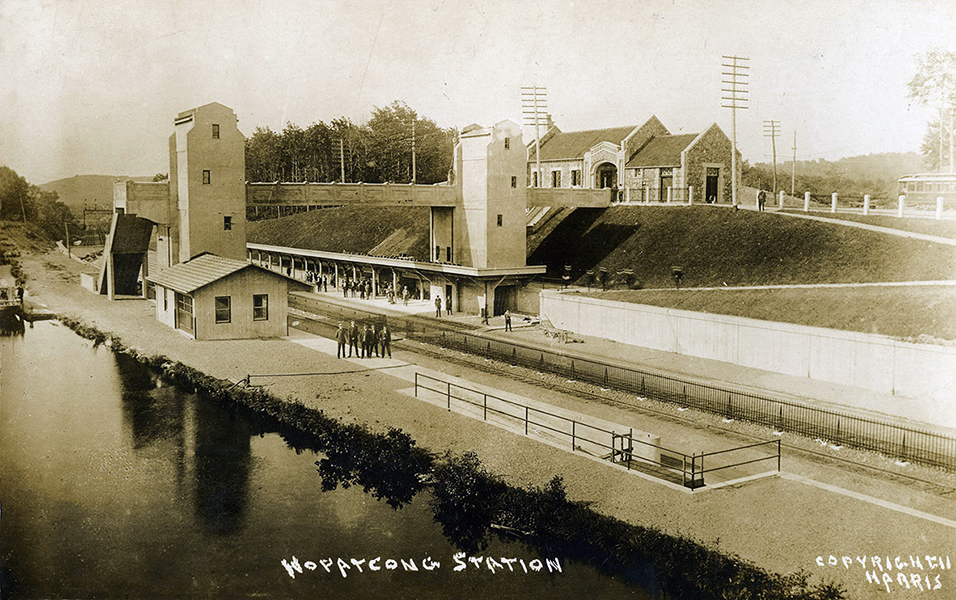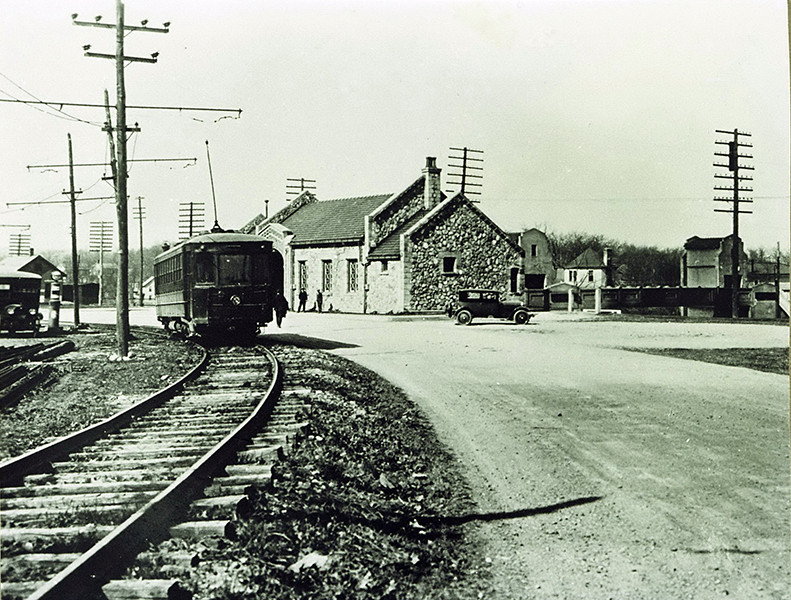The historic Lake Hopatcong train station, which now houses the Lake Hopatcong Foundation, was built over one hundred years ago when Lake Hopatcong was a vibrant and growing resort. A gift to Lake Hopatcong from the Delaware, Lackawanna and Western Railroad (commonly known as the Lackawanna) as part of the massive Lackawanna Cutoff project, the station was intended as a showcase for the railroad and an impressive entry point to the lake.
Opened in 1911, it provided a significant link to the lake for visitors and residents alike through the 1950s. As rail service diminished, the building declined and was finally sold in the 1970s by then-owner Conrail. During the ensuing years, it functioned as a real estate office and a succession of businesses including a hardware store, interior design shop, and a hobby and gaming store. Later, the future looked dim for the iconic structure when, after sitting empty and for sale for some time, some proposed uses for the site would require gutting or demolishing the station.
Everything changed when the building was purchased on November 6, 2014, by the Lake Hopatcong Foundation, as its new home.

____________________________________________
 The original route of the Delaware, Lackawanna and Western Railroad meandered through the hills of western New Jersey with many sharp curves and steep grades, making it difficult for the company to compete with other rail lines for traffic to the west. The solution was the Lackawanna Cutoff, an ambitious construction project costing a then astronomical $11 million, which was built in an almost straight line between Hopatcong Station and the Delaware River. The project pioneered the use of reinforced concrete and was compared at the time to the Panama Canal. Its use of bridges, tunnels, and viaducts removed curves, grades, and railroad crossings, allowing trains to travel at 70 miles per hour over most of the route from Lake Hopatcong to the Delaware River. As a result of the time saved along the route to Buffalo and points west, business on the Lackawanna boomed for many years.
The original route of the Delaware, Lackawanna and Western Railroad meandered through the hills of western New Jersey with many sharp curves and steep grades, making it difficult for the company to compete with other rail lines for traffic to the west. The solution was the Lackawanna Cutoff, an ambitious construction project costing a then astronomical $11 million, which was built in an almost straight line between Hopatcong Station and the Delaware River. The project pioneered the use of reinforced concrete and was compared at the time to the Panama Canal. Its use of bridges, tunnels, and viaducts removed curves, grades, and railroad crossings, allowing trains to travel at 70 miles per hour over most of the route from Lake Hopatcong to the Delaware River. As a result of the time saved along the route to Buffalo and points west, business on the Lackawanna boomed for many years.
While the Cutoff started just west of Lake Hopatcong, a new station for the lake was included in the project’s budget. Built at a time when thousands of travelers passed through the station every week en route to summer cottages, hotels, and campsites, the new station was meant to be a showpiece for arriving visitors. The station opened on May 28, 1911 – seven months before the completion of the Lackawanna Cutoff and just in time for the summer season at the lake. Built of native rough stone with cement trim, it featured a green glazed tile roof and an oak and plaster interior that included a ticket office, main hall, and baggage room. Elevated walkways with large elevators transported passengers and luggage to street level or to steamboats waiting to take passengers to Lake Hopatcong via the Morris Canal. Construction of the building reportedly cost the railroad $13,000, with the accompanying structures adding another $75,000.
___________________________________________
The station at Lake Hopatcong was unique in that three forms of transportation crossed at its doors. The Lackawanna first laid tracks through Landing in the 1850s, placing them alongside the Morris Canal. As there was no station at Landing in those years, passengers had to exit the train at Drakesville (now Ledgewood) and travel by stagecoach over rough roads to the lake. A stop was added at Landing in the 1870s but it was not until the 1880s that a station was built. Passengers arriving by train could then cross the platform, board a waiting steamboat from the Lake Hopatcong Steamboat Company, and proceed westward on the canal to the Lake Hopatcong feeder canal through a lock (located where the State Park dam is today) and onto the lake to their hotel, cottage, or campsite.
 Trolleys also traveled past the Lake Hopatcong station. Chartered in 1899, the Morris County Traction Company introduced trolleys to northwestern New Jersey. At its peak, the company’s service stretched from Newark and Elizabeth to Lake Hopatcong, utilizing some 50 miles of tracks across the state. The first section built was along Blackwell Street in Dover in 1904. Service began between Dover and Wharton that same year and soon expanded to Rockaway. The trolley line headed west from Dover through Wharton, Mine Hill, Kenvil, Succasunna, and Ledgewood, reaching Landing in 1908. At Landing, the trolley passed directly in front of the railroad station before crossing over the railroad tracks (on the same bridge which passes over the railroad at Landing today) and ended its route by the steamboat dock at the foot of Lake Hopatcong (near today’s Landing traffic light).
Trolleys also traveled past the Lake Hopatcong station. Chartered in 1899, the Morris County Traction Company introduced trolleys to northwestern New Jersey. At its peak, the company’s service stretched from Newark and Elizabeth to Lake Hopatcong, utilizing some 50 miles of tracks across the state. The first section built was along Blackwell Street in Dover in 1904. Service began between Dover and Wharton that same year and soon expanded to Rockaway. The trolley line headed west from Dover through Wharton, Mine Hill, Kenvil, Succasunna, and Ledgewood, reaching Landing in 1908. At Landing, the trolley passed directly in front of the railroad station before crossing over the railroad tracks (on the same bridge which passes over the railroad at Landing today) and ended its route by the steamboat dock at the foot of Lake Hopatcong (near today’s Landing traffic light).
Like other trolley lines throughout the country, the Morris County Traction Company sought ways to increase usage, particularly on weekends. Nationwide, many amusement parks and recreational facilities were established at the end of trolley lines for just this reason. Beginning on Decoration Day (now Memorial Day) 1910, Morris County Traction expanded service from Landing to a beach constructed at Bertrand Island, making it accessible to large numbers of people in northern New Jersey and setting in motion the chain of events which would result in the development of Bertrand Island Amusement Park.